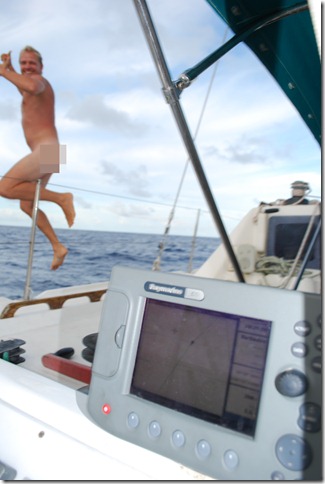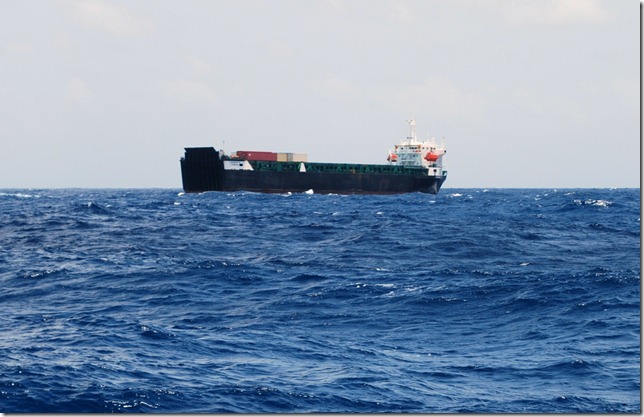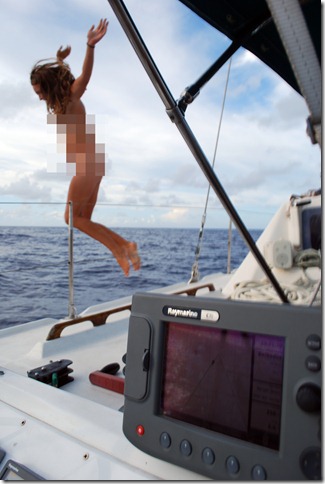Lat: 13 19.178′ S
Lon: 59 39.576′ W
After more than 2100 miles and 18 days at sea, we spotted Barbados. Yesterday we finally put the small spinnaker up and made nice time through the night and today, giving us four days with an average speed over 6 knots. The four days of good speed let us time our arrival before sunset today. With less than an hour to go before we’re motoring toward a mooring and a warm greeting from our friends on Bahati and the sounds of local radio in the cockpit, we’re starting to get excited. Our last really long passage is nearly over and our introduction to the Caribbean is about to begin…
Lat: 11 20.401′ N
Lon: 55 03.851′ W
We’re reading books, playing cards, talking, reading up on the Caribbean, and enjoying afternoon beers, but the big question on board for the last few days has been “Friday or Saturday?” for our arrival day in Barbados. We’re both hoping for Friday, both for the end to the passage and for the extra weekend night ashore. As long as the wind and current stay with us, we should make it.
The last couple of days have brought us much improved conditions and speeds. We finally broke out of the counter-current at about 9.5 degrees north and picked up a favorable current instead. At the same time, the seas have moved aft to the quarter or stern for the most part, and for the first time since we left Brazil, over 2 weeks ago, we have actually had pleasant sailing. The apparent wind is still fairly fresh and near the beam and the result is that with the jib and double-reefed main, we’ve tallied up 312 nm in two days. That leaves us with about 300 nm to go.
The other day one of our friends just completed his solo circumnavigation by reaching the Caribbean and is now sailing across the Caribbean Sea back towards the US. His comment on the radio was that for the first time in several years he’s no longer sailing a course toward a new, exciting, and unknown destination. He definitely sounded a little bummed. We still have the Caribbean to explore briefly before dealing with the same experience, but we’re already starting to think about life back on land and finding ourselves with the same mixed emotions. While it will be nice to have things like US-standard conveniences and consumer opportunities, an income, proximity to friends and family, and freedom from boat maintenance, we’re definitely going to miss the challenges, adventure, and experiences that we’ve become accustomed to for the last couple of years. For the first time in several years, our planning is starting to include things like jobs, apartments, life without a boat, etc. It’s all a little surreal. Not as surreal as finally leaving Florida, but strange nonetheless. For now, though, we have a couple more months to soak it all in before our next port of call is a familiar one.
Lat: 8 31.419′ N
Lon: 49 12.110′ W
Well, it’s been almost two weeks since we left Brazil, but frankly, it feels more like two months. I think there are several reasons for this, one of them being that we are nearing the finish line in terms of our circumnavigation and, like a marathon runner in the 25th mile, we are getting pretty weary but must press on. There also hasn’t been much to break up the monotony on board. Our radio friends have all reached their Caribbean destinations and no longer tune in, nor have we been able to pick up any news on the radio. It has just been us and the flying fish — until last night, that is.
Dallas had warned me before my watch last night that we had entered shipping lanes. Early on, I saw the glow of a couple of ships on the horizon but could not pick them up on the AIS. Without the AIS, we must rely on good old fashioned eyesight. We line up the boat (using its lights at night) with a fixed point on our boat (e.g., the port bow) and then monitor the changes of the boats’ lights relative to that fixed point to see if the boat is moving forward or aft of us, for example.
So around midnight, I began to monitor a glow on the horizon that was lined up with our bow. Unfortunately, after 20 minutes of monitoring, the glow had turned into multiple bright lights, and the lights’ position had not changed relative to our bow, indicating that we were on a collision course. This continued even after I altered our course by 10 degrees to starboard. I tried hailing them on the VHF ("vessel at appromixate position…do you copy?") but received no response, so I woke Dallas up for moral support. He tried hailing them as well using both English and Spanish ("barco grande"?) but to no avail. By now the lights were very bright, and the way they bobbled through the water toward us, they appeared to be fixed to some aquatic spaceship. This was clearly a large fishing boat rather than a cargo ship, which would have had fewer lights that would have indicated its direction (e.g., red for port side) rather than just being lit up to high heaven. Dallas and I were worried enough about the possibility of collision that we put on our life vests as we continued to stare at them through the binoculars and try to determine the most appropriate course of action. Eventually we decided that a sharp turn to port would be best and used the port engine to help make it happen. A few minutes later, the monstrosity passed our starboard bow and bobbled off into the night.
As my adrenaline levels dropped, I hoped we wouldn’t have to deal with that again anytime soon, but I was a little too optimistic (not the first time, LOL). Around 11 a.m, we had more or less the same thing happen, this time with an unusually small container ship. Dallas tried hailing them on the radio in various languages with no reply. In the daylight, it was easier to determine the ship’s trajectory, so we altered course a little sooner, but again, if we hadn’t… The AIS happened to kick in as we were clearing the ship and informed us that we were about a third of a mile from it. That sounds like a lot, but when you are at the mercy of factors beyond your control such as wind, seas, and current, you need this much leeway. And it doesn’t seem like too much to ask given the enormity of the surrounding ocean!
We have heard that ships’ captains can be penalized if they bring their ship within a half mile of another vessel. However, it seems that there are so few sailing boats out here that rather than keeping watch, captains tend to rely on radar and AIS, which don’t always pick up the smaller vessels. Another case in point was the near miss that our Frenchy friends on S/V RDJ had with a cargo ship between South Africa and Namibia. Unfortunately they had to turn into the wind to avoid the cargo ship and ended up tearing their jib in the process. The captain of the ship radioed afterward to apologize, saying he saw them only after they changed course. The rules of the sea require that motor vessels give way to those under sail, but obviously that is not to be relied on!
OK, time to get off my soapbox and start looking out for more traffic. On a positive note, the wind is coming more from the quarter, so the motion is much better, and we’re making pretty good speed despite a little bit of counter-current. Less than 700 miles left…
Lat: 05 25.110′ S
Lon: 43 14.760′ W
If only we had buckets of fresh water. We could dump our clothes in and some detergent in, put a lid on top, and the motion of the boat in these beam seas would have them clean in no time. Being on a heavy catamaran, we actually don’t have any room to complain. We ended up double-reefing the main not long after finding the NE trades and just finished taking down the main completely (in 25-30 knots after sunset of course) and are still pushing 7 knots in the gusts. The conditions actually aren’t far from what we anticipated. The North Atlantic trades have a reputation for being reliable and strong, unlike their South Atlantic cousins, which are often light. After 3500 miles of South Atlantic trades, however, we’d sort of gotten used to sailing being a comfortable, if slow affair and are still getting used to having the full force of the trades on the beam instead of on the quarter where we usually keep them. Lauren has the better stomach, so she does better than I do, though I haven’t been too bad. I have had to start eating more food, as the constant motion seems to burn more calories and hungry and the onset of seasickness feel the same at sea. There are a couple of boat projects I’d like to get to, but they’re going to have to wait for calmer seas or Barbados.
After leaving South Africa, the trip has felt a little like a delivery to the Caribbean with short, hurried stops and lots of miles at sea. By time we make Barbados, it will be about 5300 miles at sea with only a 3-day stop in St. Helena and a 1-week stop in Recife that we extended in order to get our spinnakers repaired. Luckily we have some longer stops with friends and family planned for the Caribbean. With all that time at sea, a slow start to this passage, and then the new motion to get used to, yesterday was one of those “Are we there yet?” days. Earlier than usual for me, but at least we’re making good speed.
I just had to put down the blog for a minute to toss back a flying fish. Lauren was in the galley cooking when I smelled fresh fish, even though we haven’t had a hook out today. Her guess was that the fresh fish had come to us, and sure enough, there was a flying fish on the grate where you step out from the salon into the cockpit. He was still gasping for air when I tossed him back in, so it looks like he’ll make it, unlike his dried buddies that we’ve been finding on deck in the morning. There have been a lot of healthy-looking flying fish around the last few days. Some of the school sizes are the largest I remember seeing (40-50 breaking the surface at once) and some are nearly as big as in the Pacific.
With the double-reefed main taken down and our speed back under 7 knots, things are a lot more comfortable. The relationship between boat speed and comfort is an interesting one. If you’re too slow or drifting, it can be quite uncomfortable as the waves toss the boat around easily. As you gain speed, the boat has its own forward momentum and the force of the wind in the sails, countered by the leeward hull (or keel in a monohull) gives the boat more stability. As the wind, waves, and boat speed increase, things can start to get uncomfortable again. Large waves send the boat heading off course (imagine the road underneath a speeding car being lifted and then twisted) while the autopilot fights back. The boat’s kinetic energy is proportional to the square of its velocity, so at 8 knots you’re slamming into waves with more than twice the energy as when you were going 5.5 knots, and the bangs and quick jerks let you know it’s time to trade another day on passage for a more comfortable ride and less stress on the boat. I think 6+ knots on just the jib is my favorite way to sail anyway. You’re making good speed and can sleep easy knowing that whoever ever is on watch won’t have to do anything more than ease the sheet in or out or maybe roll in a little bit of the sail if the wind picks up even more.
That’s all for now. Cheers to Lauren for yet another delicious meal. Dinner looks fabulous…
Lat: 2 56.117′ S
Lon: 38 46.153′ W
There’s a tradition among sailors when crossing the equator. One must strip down to his/her birthday suit and jump off the boat into the typically calm, doldrum waters, thereby joining the club of the Shellbacks. (We’re not sure why it’s termed that but guess that it has something to do with the turtle speeds at which one is usually sailing across the equator.) When we crossed the equator the first time en route to the Galapagos, it was the middle of the night, so we didn’t observe the tradition. This time we motored for an hour or two to be sure to make it before sunset. While we made our preparations, we accidentally motored across the "line", but we slowly drifted back across so that I could jump in at precisely the right moment. Dallas monitored the chart-plotter with the camera in hand and gave me the signal when it was time to jump. Then we motored back across the line so he could have his photo-op. We decided it was probably unwise to jump at the same time just in case the wind suddenly picked up and carried our boat away from us as we helplessly watched it go!
And Away We Go! Lifetime member of the Shellback Club
Lifetime member of the Shellback Club
There was a slim chance of that, though. The doldrums or ITCZ (Inter-Tropical Convergent Zone) have lived up to their reputation of light winds and squalls. We saw our first squall in the distance as we were engaging in our shellback induction ceremony. Later that night when I was on watch, I stepped out in the cockpit to find that we had been surrounded by dark clouds so dense that they even blocked out all the light from the super-moon. It didn’t start raining until Dallas’ watch, though, so while he was stuck going out in the downpour every 15 minutes, trying (probably in vain) to see ships in the distance, I was able to listen to the pitter patter of the rain from my cozy spot in the starboard berth.
We had been told by those who sailed through here in the last couple of weeks that they picked up the tradewinds around 2 degrees north, so instead of sailing the rhumb line to Barbados, we’ve been heading north-northwest to find the wind as soon as possible. After a couple of days of this, we arrived at 2 degrees, and sure enough, found some steady northeast winds. At just over 6 knots, we are sailing faster now than we have been able to motor-sail since leaving Brazil! I was even prompted to put out the fishing line as we are finally going fast enough to snare one, and the sun made a welcome appearance today as well.
The only drawback is that along with the winds come the seas. We have small but steep seas on the starboard beam that are making activities of daily life a little more complicated, but we’re still pretty comfortable. Saying that, both of us are really looking forward to making landfall, and we still have 1400 miles to go… The Frommers’ guide to the Caribbean with descriptions of restaurants, sights, and nightlife in Barbados is our new favorite book!



